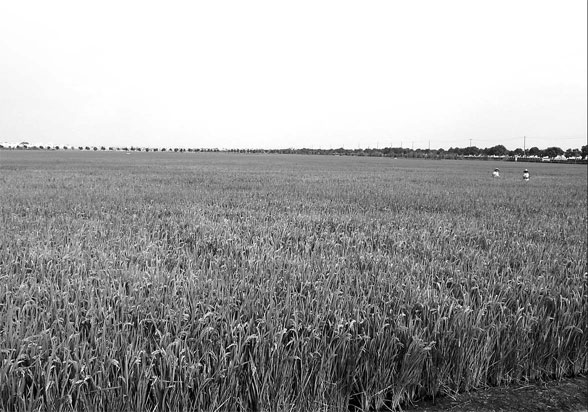


One of the greatest errors of our time is believing that increasing food production can be achieved by fighting nature. Killing all insects in an area and destroying the soil by applying vast amounts of chemicals to nurture a single crop on thousands of hectares have turned fields into sterile factories, not food-baskets.
Industrial agriculture may have worked for a few years. It may even have yielded some stunning harvests for a while. But today we know this approach to farming is a dead-end. It fails in the long-term because it compromises the very resources on which our food supplies depend. Soil deteriorates, water becomes scarce and contaminated, dependence on increasing amounts of fertilizer results in ever decreasing yields, weeds become resistant to pesticides, and pests more difficult to control. Around the world there are numerous examples of regions that once were breadbaskets but now are sandy dustbowls laden with pollutants and devoid of water and life.
This is not an environmentalist's scaremongering; it is the consensus of the global scientific community. Last week, governments and scientists from all around the world gathered in Johannesburg, South Africa, to debate the final report of the first ever council on world agriculture - the International Assessment of Agricultural Science and Technology for Development. Several hundred scientists worked for three years to take stock of the current global state of farming.
Their final report - which was adopted by over 60 governments, including China - is a sobering account of industrial farming's failure. It concludes that chemical-intensive agriculture fails to meet local communities' needs for building their livelihoods and achieving a healthy, varied diet. The report calls for a systematic redirection of agricultural research, to better address hunger, severe social inequities and environmental problems.
Negative factors
Today, rocketing prices have created a severe food crisis, putting key staples beyond the reach of the world's poor. Key triggers are climate change, which is disrupting weather cycles, increasing drought and floods, contributing to poor harvests. And the rush for biofuels in international markets, mainly driven by policies in the United States and European Union, which is diverting productive land away from food to fuel, increasing speculation in commodity markets.
The rise in oil prices is also increasing food costs because industrialized agriculture is addicted to fossil fuels. All synthetic fertilizers, pesticides, machinery and, last but not least, food's long transport route, need fuel. And the increased demand for meat is forcing grain to be diverted from feeding people to feeding livestock. To produce 120 kilograms of meat - the annual average of a person living in the US - requires 750 kg of grain for animal feed. Not only is this an unhealthy diet, it is devastating for the world's undernourished poor.
The answer to this crisis is not more of the same, but a fundamental re-orientation of agriculture on a global scale. As the International Agriculture Assessments emphasizes, "the ecological footprint of industrial agriculture is already too large to be ignored". As a start, it recommends taxing the use of agrochemicals and fossil fuels to help reduce some of the damaging effects of industrial farming. For the most devastating practices, such as using toxic chemicals near streams, the report calls for an outright ban.
Indeed, the facts are sobering. In China, "nutrient" pollution from chemical intensive agriculture represents a major threat to ground water, rivers, lakes and coastal oceans. Today, more than 85 percent of the nation's lakes are under serious nutrient pollution stages. Nutrient pollution can lead to massive algae blooms, the most infamous, well-known example of which is threatening China's third largest fresh water lake, Taihu Lake. Some type of algae can produce toxins that can sicken or even kill human and aquatic organisms. During 2007, 82 cases of harmful algal blooms were reported in Chinese coasts, covering 11,610 square km of seawater. Algae blooms can lead to the creation of dead zones in coastal oceans where lack of oxygen makes it impossible for fish, crabs and other animals to survive. In 2006, the United Nation Environment Program declared both the Pearl River estuary and the Yangtze River estuary as new dead zones.
Half a million tons of toxic pesticides are released into the environment in Asia each year, with China one of the largest consumers of pesticides in the world.
So what is the alternative? How do we increase productivity to feed seven, eight or even 10 billion people globally, without converting more land to agriculture and resorting to the destructive technical methods of the past? Some say genetic engineering (GE) is the answer. The International Agriculture Assessment is very clear that it does not see GE crops as any kind of solution to poverty and hunger. In contrast, it suggests a broad range of options that can be best described as intelligent farming. This includes farming that is ecological and champions biodiversity. Farming that is adapted to local needs and conditions, which uses local seed varieties as well as local and traditional knowledge.
Solutions
The modern way of farming should work with nature and with people, not against them. Millions of farms on all continents already prove that ecological and sustainable agriculture can provide sufficient food, increase food security, replenish natural resources and provide a better livelihood for farmers and local communities.
To exploit fully the potential of agriculture that is healthy and rich in biodiversity requires a sea-change in research priorities. Governments need to ensure that the majority of expenditures for agricultural research - nationally as well as internationally - and its dissemination is invested in farming systems that do not pollute or deplete natural resources, and which enable communities to feed themselves and others with a nutritious and balanced diet.
The future of farming is green, and it promises sufficient food for all of us.
The author is International Executive Director of global environmental organization Greenpeace. The views expressed in the article are his own. He can be reached at gerd.leipold@int.greenpeace.org.
(China Daily 04/28/2008 page4)













